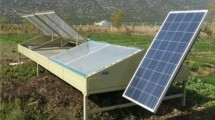Abstract
Silkworm pupae are major by-products of silk reeling industry obtained after reeling considered as waste material and discarded in open environment. Dead pupae are highly perishable and found to be a rich source of protein and fat. Value addition to silkworm pupae can be enhanced by suitable preservation methods and by conversion of silkworm pupae into convenient processed products for wider market acceptability in different regions. In this study a forced convection solar tunnel dryer of 60 kg batch capacity was developed for drying of fresh silkworm pupae having size of 6.58 × 1.8 × 1.1 m (L × W × H) with MS square tube frame structure covered with 5 mm thickness toughened glass. The solar tunnel dryer consists of a solar collector section (6.48 m2) and drying section (4.32 m2) and a ceiling height of 1.1 m. In drying section four trays of size 1.2 × 0.9 × 0.08 m with mesh bottom were used to facilitate the loading and unloading of the silkworm pupae during drying. To reduce the heat loss from the dryer, closed thermopore were used as insulation material. The drying time required in open sun drying was 18–22 h and in the solar tunnel dryer was 7.5–9.00 h for different treatments of silkworm pupae from initial moisture content of 103.32–145.45% (d.b) to attain safe moisture content of 9.97–8.72% (d.b). To achieve higher drying rates, three axial DC fans, 20 W photovoltaic solar panel powered were fitted, to suck the moist air from drying chamber and push it out through a circular duct. The results showed that the drying rate of silkworm pupae under the solar tunnel dryer was found to be very high during the initial phase of drying due to higher moisture diffusion. The maximum temperature attained in the solar tunnel dryer was 95.6 °C at ambient temperature of 36.20 °C during drying period of silkworm pupae.







Similar content being viewed by others
References
RN Datta SK Majumder PK Chinya 1993 Pupae waste may be a source for amino acids preparation Indian Silk 32 1 4 5
G Gurlek N Ozbalta A Gungor 2009 Solar tunnel drying characteristics and mathematical modeling of tomato J. Therm. Sci. Technol. 29 1 15 23
RJ Lewicki DJ Mcallister R Bies 1998 Trust and distrust: new relationships and realities Acad. Manag. Rev. 23 3 438 458
N Roy Choudary KC Joshi 1995 Silkworm pupae as human food Indian Silk. 34 4 10
G Savithri P Sujathamma 2016 Mulberry and silkworm as a healthy foodstuff—a review Int. J. Recent Sci. Res. 7 6 12244 12246
S Shanmukhappa BM Kulkarni 2015 Investigations on through recirculation drying of dead pupae for recovery of pupae oil Indian J. Chem. Technol. 22 1 2
Y Sujatha P Issac M Prahlada Rao 2016 The importance of silkworm pupa solar dehydrator in silk reeling manufacturing industries Int. J. Innov. Res. Adv. Stud. IJIRAS 3 9 52
T Usub L Charoenporn P Nattapol W Lamul S Sirithon S Somchart 2010 Thin layer solar drying characteristics of silkworm pupae Food Bio-products Process. 88 2 3
R Tunde TY Akitunde 2011 Mathematical modelling of sun and solar drying of chili pepper Renew. Energy 36 2139 2145
Funding
The authors would like to thank research grants sanctioned by the Director of Research, University of Agricultural Sciences, Bangalore-560065 for development of the multipurpose solar tunnel dryer for sericulture industry.
Author information
Authors and Affiliations
Corresponding author
Ethics declarations
Conflict of interest
The authors declare that they have no conflict of interest.
Additional information
Publisher's Note
Springer Nature remains neutral with regard to jurisdictional claims in published maps and institutional affiliations.
Rights and permissions
About this article
Cite this article
Manvi, D., Shriramulu Development and Performance Evaluation of Forced Convection Mobile Solar Tunnel Dryer for Drying of Silkworm Pupae. J. Inst. Eng. India Ser. A 103, 195–201 (2022). https://doi.org/10.1007/s40030-021-00565-6
Received:
Accepted:
Published:
Issue Date:
DOI: https://doi.org/10.1007/s40030-021-00565-6




